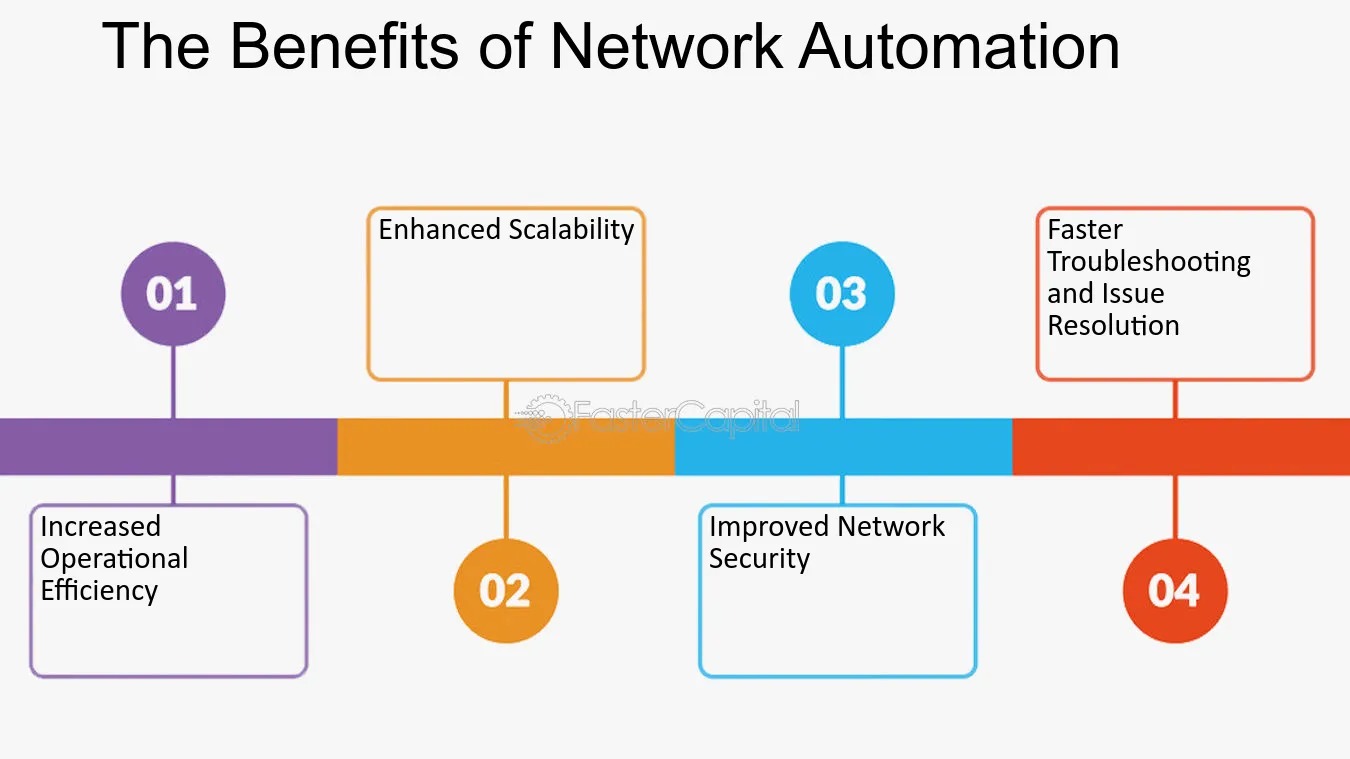
In today's interconnected world, network infrastructure serves as the lifeblood of businesses and organizations, facilitating communication, data transfer, and the delivery of critical services. The efficiency and productivity of these networks are pivotal to an organization's success. As the digital landscape continues to evolve, the demand for streamlined and optimized network operations has never been greater.
Enter network automation, an innovative and transformative solution that promises to revolutionize the way we manage and maintain our networks. Network automation refers to the use of technology and processes to automate the configuration, management, and maintenance of network devices and services.
Whether you're operating a data center, a cloud infrastructure, or a complex enterprise network, the benefits of network automation are tangible and far-reaching. In this article, we will discuss how does network automation enhance efficiency and productivity.
What Is Network Automation?
The practice of employing software to automate security and network provisioning and administration in order to optimize network functioning and efficiency continually is known as network automation. Automation of networks is frequently used in combination with virtualization of networks.
IT departments in today's world are looking for speed, agility, and consistency when it comes to the provisioning and management of cloud-native apps as well as legacy applications. The automationof networking tasks such as resource provisioning, network mapping, and network testing is one of the ways in which a contemporary network automation platform might accomplish these objectives.
Network automation is applicable to a variety of businesscontexts, such as data center, corporate, and service provider networks. Additionally, it may be used with WiFi, WAN, and LAN networks, as well as local area networks.
Companies may enhance the overall efficacy and efficiency of their IT infrastructure by combining network automation with other automation types, such as security and IT automation.
Benefits Of Network Automation
The following are a few advantages of network automation;
Removes The Risk Of Human Error
Even with IT staff members who are competent in doing them, lengthy and laborious manual operations involving network devices are prone to mistakes. Automating these kinds of procedures is likely to reduce the likelihood of errors occurring even when network updates are executed properly the first time.
Automatic network setup not only reduces the likelihood of problematic events brought on by human modifications but also keeps the network from malfunctioning, hence boosting dependability. Additionally, network security policies have become more straightforward to implement, making security audits passable without the need for additional research.
Lightens The Workload Of IT Personnel
IT personnel need to check if network-related procedures were initiated and executed without a hitch. However, they also need to stay vigilant for any possible issues. Additionally, since reports including this information are frequently already accessible, they do not need to record configuration changes made to network devices.
As a result, IT employees are able to concentrate on essential projects that lead to business enhancements and try to optimize their procedures, which increases productivity.
Standardizes Processes
Even when daily maintenance tasks grow regular, potentially problematic circumstances within the IT infrastructure are avoided with standard practices deployed throughout the network. The individual in line, after a network administrator departs, could be just as qualified to handle administrative duties as more senior, seasoned employees.
Nevertheless, it is essential to remember that your firm may not necessarily need to reduce workers just because it has introduced network automation because competent individuals are still required to execute the processes.
Strengthens Resistance
Unlike a manual setup where activities that take time may be ignored because of the effort needed, automatic updates and adjustments that are carried out routinely and without fail are the means by which optimal network performance is accomplished.
Additionally, because tools are now available to monitor network performance and notify personnel of potential errors before they arise, network automation leads to more straightforward management tasks. This helps staff avoid downtime and meet service-level agreements with minimal effort.
Enhanced Scalability
The scalability of your IT infrastructure may be enhanced by network automation, even as it performs intricate analysis using inputs from the many devices connected to your network. It enables the quick deployment of new apps, devices, and services that are built around repeatable and well-established procedures.
Additionally, network automation enables your network to manage rising use demands before they have an adverse effect on performance. In manual networks, this scaling would only be feasible with an extensive time and labor commitment.
Increased Productivity
Network automation significantly enhances productivity by automating repetitive and time-consuming network management tasks. It streamlines operations, reduces human errors, and accelerates network changes, leading to faster deployment of services and updates.
Automated monitoring ensures proactive issue detection and swift responses, minimizing network downtime. Additionally, automation optimizes resource allocation, allowing organizations to scale efficiently and allocate resources where needed, reducing operational costs.
As a result, IT teams can focus on strategic initiatives, innovation, and higher-value tasks, ultimately boosting overall productivity and enabling businesses to adapt more rapidly to the dynamic demands of the digital landscape.
Enhanced Effectiveness
Increasing the effectiveness, precision, and speed of network administration duties is one of the main objectives of network automation. By simplifying network operations and cutting down on job completion times, network automation can result in higher efficiency. Businesses may see an improvement in productivity and cost savings as a consequence.
Enhanced Safety
Organizations can react swiftly to changes in their network environment thanks to network automation.
Businessesmay strengthen their defenses against malicious activity and cyberattacks by performing regular backups and updates. Additionally, automation may assist businesses in identifying hazards more quickly, enabling them to take swifter action and avert any harm.
Reduced Costs
Because network automation does not require manual labor, it can save operating expenses. Businesses may now manage their networks without hiring staff since automation lowers the requirement for manual intervention. Automation lowers expenses by decreasing downtime and saving businesses money on repairs.
The Network Automation Framework's Components
Network automation acts inside a framework made up of several interconnected components, each of which carries out essential infrastructure and network tasks. We'll look at a few of the most critical sections here;
Management Of Configurations
The process of maintaining and regulating network device settings to make sure they comply with established guidelines and standards is known as configuration management. As part of this procedure, network configuration changes are usually tracked and documented, which facilitates troubleshooting and guarantees network consistency.
Network Monitoring, Event Management, And Alerting
When taken as a whole, these elements offer real-time network performance insight. They entail monitoring network traffic continually, seeing any problems before they get out of hand, and notifying users of any anomalies or security breaches that are found.
Provisioning And Management Of Devices
This includes setting up and maintaining network equipment, both natural and virtual. Remote troubleshooting, updating, and provisioning of new devices are all made simple by network automation.
Inventory And Documentation Of Networks
Effective network administration requires keeping track of every network device and its state. The time and effort required for network audits are decreased by automation, which guarantees accurate and current inventory records and aids in the maintenance of thorough network documentation.
Testing And Verification Of Networks
Verification verifies that the network adheres to established regulations and standards, whereas network testing guarantees that the network and its devices operate as intended.
Observance And Safety
Network automation aids in ensuring adherence to legal requirements and uniformly applies security measures throughout the network. It detects and fixes non-compliant setups and any security risks automatically.
Orchestration Of Networks
This entails coordinating and automating intricate network operation sequences across many systems and devices to guarantee their flawless integration.
Integration And Apis
Software applications may communicate with network devices and other software platforms thanks to APIs, which are essential to network automation. They expand the breadth of automation by making integration with other IT systems and applications more accessible.
Analytics And Reporting
Automated reporting offers insightful information on usage patterns, network performance, and any problems. It supports data-driven decision-making by network administrators.
Network Automation Tools And Technologies
Network automation tools and technologies have emerged as indispensable assets in the realm of modern IT infrastructure management. They empower organizations to streamline operations, enhance efficiency, and ensure the reliability of their networks.
Ansible
Ansible is an open-source automation platform known for its simplicity and flexibility. It uses playbooks, which are written in YAML, to define automation tasks. Ansible is agentless, meaning it doesn't require any software to be installed on network devices, making it an attractive choice for many organizations.
Puppet
Puppet is a widely used configuration management tool that automates the provisioning and management of infrastructure. It enables administrators to define the desired state of network configurations and ensures that they remain consistent across devices.
Chef
Chef is another configuration management tool that automates the deployment of applications and infrastructure. It uses "recipes" to define how systems should be configured. Chef excels in managing complex infrastructures and has a strong developer community.
Terraform
Terraform focuses on infrastructure as code (IaC) and is used for provisioning and managing cloud resources. It supports multiple cloud providers and allows users to define infrastructure components in code, which can be version-controlled and easily reproducible.
Cisco DNA Center
Cisco DNA Center is a network automation and management platform specifically designed for Cisco networks. It provides centralized control, automation, and assurance for Cisco networking devices, simplifying the management of large-scale networks.
Apis And Scripting
ApplicationProgramming Interfaces (APIs) play a crucial role in network automation. They allow for programmatic interaction with network devices and services. Scripting languages like Python are commonly used for automation tasks, providing flexibility and extensibility.
Cloud-Native Automation
As organizations increasingly adopt cloud services and hybrid cloud architectures, cloud-native automation tools and frameworks are becoming essential.
These tools enable the automation of cloud resource provisioning, scaling, and management. Collectively, these tools and technologies provide a spectrum of solutions for network automation, catering to various needs and preferences.
They facilitate tasks such as device provisioning, configuration management, compliance enforcement, and network monitoring. By automating these processes, organizations reduce manual errors, enhance network agility, and ensure consistent configurations, resulting in improved operational efficiency and productivity.
Things To Consider While Automating
Increasingly, organizations of all kinds are recognizing the need to automate their networks. On the other hand, while searching for a solution for network automation, it might be challenging to determine what is most suitable for your network.
In order for businesses to reap the benefits of network automation and maintain their competitive edge in the market, they require the appropriate tools and methods.
They can achieve maximum efficiency, accelerate deployment, and save money in the long run if they have the appropriate answer. When looking for solutions for network automation, three aspects should be taken into consideration.
Patch Management
It is the responsibility of patch management to guarantee that all of the software and hardware on your network are running the most recent version and are up to date.
This is necessary for the protection of the network since obsolete software versions might leave the network open to the possibility of hostile assaults or data breaches.
In addition, it is essential for maximum performance because using outdated software might cause your network to slow down, which can result in crashes or slowdowns.
Surveillance Of Networks Automatically
When it comes to maintaining the seamless operation of your network, automated network monitoring is essential.
Through the use of automated monitoring, you will be able to identify and diagnose issues in real-time, therefore guaranteeing that your network is constantly operating at its highest possible level. Time and money will be saved, and costly downtime will be avoided as a result of this.
Automated Security Policies
A feature that is essential for any network automation system is the ability to implement automated security policies. Having automated security rules in place will assist in maintaining the safety of your network and shielding it from potential dangers, hence lowering the likelihood of data breaches and other security problems.
Frequently Asked Questions
What Is The Impact Of Network Automation On Its Teams?
Network automation allows IT teams to focus on strategic initiatives and higher-value tasks, boosting overall productivity.
How Does Automation Improve The Reliability Of Network Configurations?
Automation ensures that network configurations remain consistent across devices, reducing configuration errors.
What Benefits Does Network Automation Bring To Adapting To Dynamic Network Demands?
Network automation enables businesses to adapt more rapidly to changing network requirements, supporting agility and growth.
Final Words
The transformative power of network automation is undeniable. It is crucial to understand how does network automation enhance efficiency and productivity. By streamlining operations, reducing human errors, and ensuring the reliability of network configurations, automation not only enhances efficiency but also significantly boosts productivity.
It empowers IT teams to focus on strategic endeavors, accelerates network changes, and proactively detects and mitigates issues, ultimately enabling businesses to adapt swiftly to dynamic network demands.
As technology continues to advance, network automation remains a fundamental tool in maintaining a competitive edge and ensuring a robust, agile, and productive network infrastructure.





